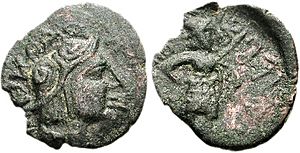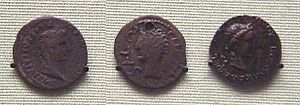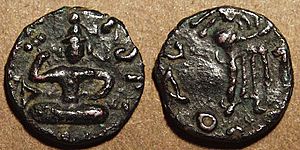Kujula Kadphises facts for kids
Quick facts for kids Kujula Kadphises |
|
|---|---|
| Kushan emperor | |
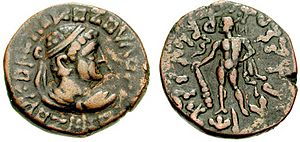
Tetradrachm of Kujula Kadphises (30-80 CE) in the style of Hermaeus.
Obv: Hermaios-style diademed bust. Corrupted Greek legend: ΒΑΣΙΛΕΩΣ ΣΤΗΡΟΣΣΥ ΕΡΜΑΙΟΥ ("Basileos Sterossy Hermaiou"): "King Hermaeus, the Saviour". |
|
| Reign | 30 CE - 80 CE |
| Predecessor | Heraios |
| Successor | Vima Takto |
| Died | 80 CE |
| Dynasty | Kushan |
Kujula Kadphises was a very important ruler who lived a long time ago, from about 30 to 80 CE. He was a prince of the Kushan people. Kujula Kadphises is famous for bringing together many different groups of people called the Yuezhi. He became the very first emperor of the Kushan Empire.
Historians believe he was the great-grandfather of Kanishka I, a very powerful Kushan king. Kujula Kadphises is known as the person who started the Kushan Empire.
Contents
The Rise of Kujula Kadphises
We don't know much about where Kujula Kadphises came from. Some people think he might have been related to an earlier Kushan ruler named Heraios. His name, Kujula, was also used by some of the last Indo-Scythian rulers. This might mean they were connected in some way.
Kushan Expansion in Asia
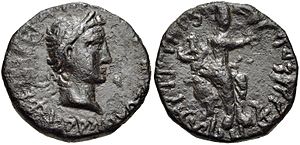
Obv Laureate Julio-Claudian style head right. Greek legend around: ΚΟΖΟΛΑ ΚΑΔΑΦΕϹ XOPANOV ZAOOV.
Rev Kujula Kadphises seated right, raising hand; tripartite symbol to left. Legend Khushanasa Yauasa Kuyula Kaphasa Sacha Dhramatidasa.
Kujula Kadphises and his son, Vima Takto, helped the Kushan Empire grow. They moved eastward and took over the Indo-Parthian kingdom. This kingdom was in northwestern India and was ruled by Gondophares.
Ancient Chinese records tell us about this expansion. They say that Kujula's son, Yangaozhen (likely Vima Takto), became king. He conquered a region called Tianzhu, which was northwestern India. He put generals in charge there. This made the Yuezhi people, who were the Kushans, very rich.
The Chinese called them the "Great Yuezhi," but other kingdoms called their ruler the "Guishuang" or Kushan king. This takeover of the Indo-Parthian kingdom probably happened after 45 CE. It was during the time of Gondophares's successors, Abdagases and Sases.
Family Tree from an Ancient Stone
We know about Kujula Kadphises's family thanks to an ancient stone carving. It's called the Rabatak inscription. This inscription was found in Afghanistan and was written by King Kanishka.
Kanishka listed the kings who ruled before him. He said Kujula Kadphises was his great-grandfather. Then came Vima Taktu, his grandfather. Next was Vima Kadphises, his father. Finally, Kanishka named himself.
The inscription says: "And he [Kanishka] gave orders to make images of the same, (namely) of these gods who are written herein, and he gave orders to make (them) for these kings: for King Kujula Kadphises (his) great grandfather, and for King Vima Taktu (his) grandfather, and for King Vima Kadphises (his) father, and for himself, King Kanishka."
Kujula Kadphises's Coins
The coins made by Kujula Kadphises tell us a lot about the Kushan people. They show how their beliefs and culture changed over time.
His earliest coins have a picture and name of Hermaeus on one side. On the other side, they show Heracles. This was a Greek tradition, but Heracles might have also represented an Iranian god named Verethragna.
Later, his coins showed that the Kushans started to worship the Hindu god Siva. This is clear from an inscription found in Mathura. It says that the kingdom was given to a later king by Sarva (Shiva) and Scamdavira. This shows that Kujula Kadphises was a follower of Shiva. It's interesting that he adopted the worship of Shiva and used the Kharoṣṭhī script so early.
See also
 In Spanish: Kujula Kadphises para niños
In Spanish: Kujula Kadphises para niños


